On Porsche, Honda Civic, NACTOY Semifinalists and more
How to get fans, adventures in EV charging, why machine learning can lead to better materials, the 11th generation Honda Civic, and much more.
This week On Automotive
- Dodge: They Really Like It
- Serious Design—Deere Acknowledged in Europe
- Porsche on Nob Hill
- Push-button Charging
- 2022 Honda Civic 1.5L Touring
- Machine Learning for a Better Magnet
- On the Subject of Machine Learning and Materials. . . .
- VW Opens €70-Million Battery Lab
- NACTOY: From 36 to 23
///
Dodge: They Really Like It
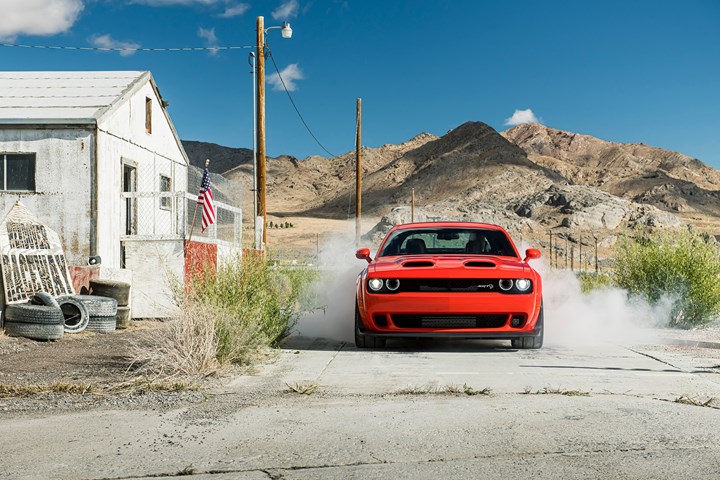
Dodge Challenger SRT Super Stock. Who doesn’t like a car with 807-hp under the hood? (Image: Stellantis)
You may have heard by now that Dodge took the top spot in the J.D. Power 2021 U.S. Automotive Performance, Execution and Layout (APEAL) in the Mass Market category.
Dodge achieved 882 points out of 1,000.
Porsche, which takes the top spot in the Premium category, achieved 882 points out of 1,000.
Yes, a tie.
Dodge sibling Ram is in second in the Mass Market category, with 881 points.
But Chrysler is literally at the bottom of the list, in 18th place, with 826 points.
So what gives?
We asked Dave Amodeo, director of Global Automotive for J.D. Power.
And he explained something that is useful to know for anyone making any kind of product that consumers interact with.*
He cited “purity of brand.”
That is, Dodge is about Performance and Muscle.
Just look at the Dodge website homepage.
Amodeo said that because the designers, engineers and marketers know their customers, who are in a fairly defined space, they are able to provide the characteristics in the vehicles that delight those customers.
(Porsche, he noted, also has a similarly focused consumer base.)
But what about Chrysler?
Amodeo said that because it has two vastly different models—the 300 sedan and the Pacifica minivan—it is more difficult to achieve a consistent brand DNA compared with Dodge, which does one thing and does it well.
Lesson?
If you want fans: Focus.
===
*The fine print about APEAL.
The survey is taken of owners and lessees of new 2021 model year cars and light trucks. There were 110,827 surveys completed, covering 32 brands.
There are 10 categories—fuel economy, setting up and starting, exterior, driving feel, getting in and out, powertrain, driving comfort, keeping you safe, interior, infotainment—and 37 different rating attributes within them.
Whereas the J.D. Power Initial Quality Study (IQS) looks at problems that customers have during their first 90 days of ownership, APEAL asks people what they like.
Notably: The top brand in the 2021 IQS: Ram. Second place: Dodge.
///
Serious Design—Deere Acknowledged in Europe
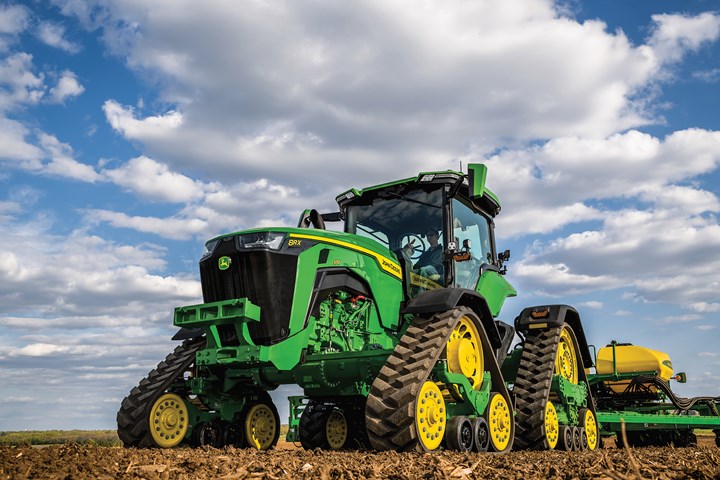
John Deere 8 Series tractor: being acknowledged for its design in Europe. (Image: Deere & Company)
We’ll admit it: When we think of ag equipment, design isn’t the first thing that comes to mind.
So we were surprised to see the list of finalists for the DesignEuropa Awards in the Industry category.
According to Christian Archambeau, executive director of the European Union Intellectual Property Office, which organizes the awards:
“The DesignEuropa Awards are an important opportunity for us to recognise not only the economic and practical impacts of innovative designs, but also their cultural impact.”
There are four finalists in the category.
One of which is from the U.S.: the John Deere 8 Series tractors.*
The other finalists are:
- a smart door handle
- a portable patient monitor
- a desk system
We’re hoping for the tractor.
*The designers: Felix Nagelin, Brian Huenink, John W. Krieger, Eric Keen, Sebastian M. Himpel, Thorsten Hagner, Daniel J. Deboer, Martin Clay, Michael D. Kollath, Richard Knowels Jr, Thomas C. Boe, Charles Warren
///
Porsche on Nob Hill
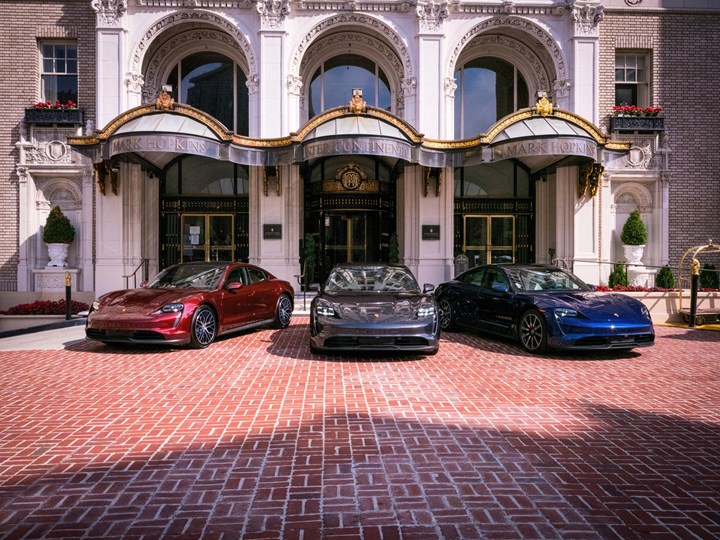
When you park your Porsche. . .in San Francisco. . . (think Tony Bennett crooning that). (Image: Porsche)
Those three Porsche Taycans are parked in front of the InterContinental Mark Hopkins San Francisco.
It isn’t at all surprising that there are Porsches on Nob Hill. There are probably an array of other expensive cars in the vicinity, electric or otherwise.
Why are those cars staged there?
Because the OEM and the hotel are collaborating: Porsche electric vehicle chargers are installed at the hotel.
It is part of a network. “Porsche Destination Charging.”
Kjell Gruner, President and CEO of Porsche Cars North America, Inc.: “We want to welcome the growing ranks of Taycan fans with charging opportunities where they already travel and play, including superb hotel destinations like the Intercontinental Mark Hopkins.”
Here are two surprises:
- There are two wall chargers. Two. There are 380 rooms in the hotel, and the charging is not limited to hotel guests, as those dining in the restaurants qualify, as well.
- They are not restricted to Taycans. Any car that accepts a standard J1772 plug can use it. (Presumably the valets will have something to do with what gets the plug. Imagine how you’d feel if you had a Taycan that needed some electricity and an i-MEV was using one of the two chargers.)
Here’s something to think about:
- What if you owned a Panamera or a 911: would they fill up your tank with premium while you ate lunch?
The electrification of the fleet, obviously, is different.
///
Push-button Charging
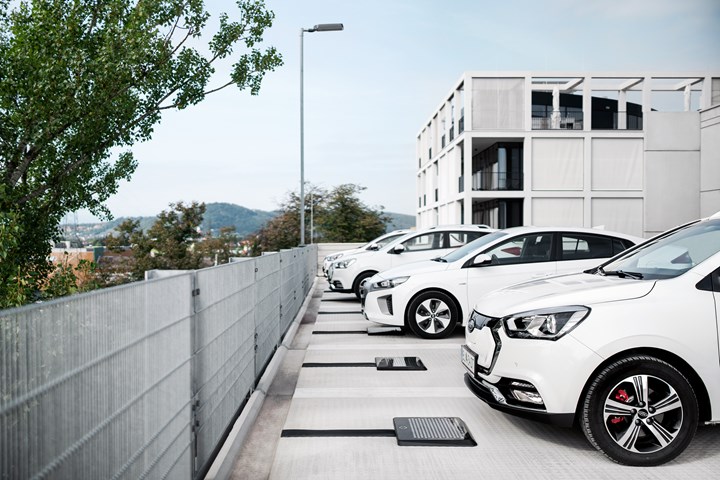
The electric vehicle rolls up so that it is on top of the charging pad. Then the driver pushes a button and a connector, surrounded by a rubber bellows, descends from the bottom of the car and meets with the pad. Charging commences. (Image: Easelink)
Speaking of electric vehicles. . .
In 2025 only taxis with emissions-free propulsion systems will be permitted to operate in Austria.
A charging infrastructure is being built out for all electric vehicles. For example, Wien Energie, which is the country’s largest energy supplier, has 1,900 public and semi-public charging stations in the greater Vienna area.
For the cabs, a multi-sponsor project (participants range from government to suppliers to OEMs to vehicle operators) is being undertaken in Graz and Vienna:
eTaxi
The concept is that cabs make money when they are operating. When they have to route to a charging station that’s not happening.
So the eTaxi program is using a system called “Matrix Charging.” The system was developed by a Graz-based company, Easelink.
How It Charges
There is a connector that can be retrofitted into vehicles. The connector, at the push of a button, descends from the bottom of the vehicle and connects with a charging pad. The connector has a rubber bellows for the vertical up-and-down movement.
The charging in the eTaxi program is with11 kW AC; the system will eventually support up to 22 kW AC and 100 kW DC at 800 volts.
So the idea is to install the charging pad at taxi stands so as the cabs wait for their fares they are being charged.
While some companies are promoting inductive charging, which means there is no physical connection between the vehicle and the charging surface, Easelink personnel argue that there is superior power transfer efficiency, on the order of 99%.
Bullish on the Approach
Paul Gredler Oxenbauer, Group Manager Charging Solutions from Wien Energie:
“For the electrification of taxi fleets, the automation of charging at the stand is crucial. This can only be achieved with a robust charging technology that can be integrated flush and thus barrier-free into the roads. Matrix Charging meets these requirements and offers high efficiency through the conductive connection. Due to the decentralized design of the charging infrastructure and a high connection time of the vehicles with the charging points, a grid-serving integration into the urban power grid can be achieved.”
///
2022 Honda Civic 1.5L Touring
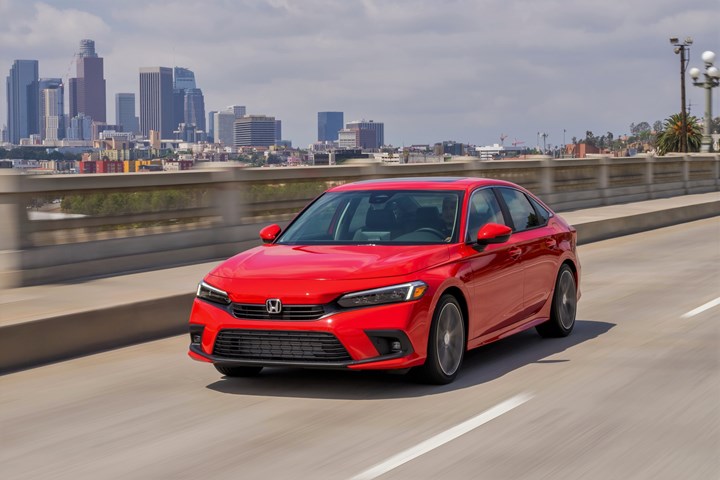
At some point you wonder: What more could you need in a compact sedan? (Image: Honda)
Early in my career I spent a lot of time in Ohio. Marysville. East Liberty. Anna.
At the Honda facilities.
I talked for hours with the people developing and producing the vehicles and engines. Discussed everything from stamping to cylinder boring, from styling to painting.
The good news is that I was able to learn an incredible amount about vehicle execution from an array of people for whom I have respect and fond memories. Many of these people were fairly or wholly new to the auto industry and didn’t know things that were “they way they’re supposed to be done.” So they figured out better ways. And if they weren’t better, they worked at continuously improving them.
The bad news is that I was able to get a point of view on how these people worked that was in high contrast to others who were, shall we say, steeped in automotive practice.
A Recollection
I recall doing a story on flexible manufacturing. Back then Honda was producing engines for the Civic and motorcycles on the same line. (Remember: the original Honda Marysville Plant was the motorcycle plant, which opened in 1979, with the auto assembly plant opening in ’82.)
When talking to the head of powertrain at one of the then-Big Three companies about its manufacturing flexibility—and there wasn’t a whole lot, to put it mildly—I mentioned what Honda was doing with its mixed-lot engine production.
“We don’t make motorcycles,” was the response.
The point of this is that I have solid respect for Honda.
Which brings me to the subject of this, the 11th-generation, 2022 Civic.
Getting Better All the Time
Since the first Civic of 1972, Honda has, globally, produced some 26-million of them. By and large, each has been an improvement. (The model year 2012 Civic, the 9th generation was. . .well they probably set a record at making the model year 2013 what a Civic is expected to be, not what cost accounting led it to be. They learn. And execute.)
The 22 Civic is a revelation. A simple, stylish sedan. While simple and stylish seem to be possibly contradictory, that’s not the case (e.g., the little black dress).
There is a low beltline which helps provide excellent visibility (you don’t need to have a crossover for good sight lines), something that Hondas have long exceled in.
Inside, it is well thought out such that it is unremarkable: things are where they should be and you don’t really have to figure anything out. Which is remarkably good.
There is a honeycomb mesh (actual metal) that runs horizontally across the IP which hides the air vents and there are toggles that allow adjustment of the direction of airflow. In this case it is contemporary and classic.
There is the use of plastic trim that has a technical pattern (without being carbon fauxber, a favorite of many interior designers, it seems) and doesn’t lend itself to the smudges that are characteristic of that other material fave, piano black.
The vehicle is powered by 1.5-liter turbocharged four that produces 180 hp @ 6,000 rpm and 177 lb-ft of torque at 1,700 to 4,500 rpm.* It is mated to a continuously variable transmission. It is interesting to note that Honda engineers worked on things like the plumbing for the turbo and added the long-known VTEC (Variable Timing and lift Electronic Control) to the exhaust valves—to improve fuel economy.
Yes, fuel economy matters to Civic owners (it is EPA estimated at 31/38/34 mpg—city/highway/combined, which I bettered without even trying).
It is notable that they just didn’t improve the engine to get the improvement: the use of low-drag front brake calipers and low-friction wheel bearings all around contribute to reduced rolling resistance and so help improve MPGs.
Which goes back to the point of learning. And executing.
*In case you are wondering: this engine is produced at the Honda Anna Engine Plant in Ohio. There is also a 158-hp 2.0-liter four that is built by Honda of Canada Mfg. So, no, not the same line. The sedan, incidentally, is also being produced by Honda of Canada Mfg. in Alliston, Ontario.
///
Machine Learning for a Better Magnet

That is a magnet for applications such as in steering motors that is said to be not only more powerful than comparable magnets, but which has 60% fewer rare earth materials. (Image: LG Innotek)
High-powered magnets such as those used in steering motors are generally produced by Japanese or Chinese companies, so a Korean company has entered the market with what it maintains puts it ahead of the competion.
LG Innotek, working with SGI (Sunglim Group Industry) Co., has come up with what it says is the “world’s strongest ‘eco-magnet’.”
The eco-part comes from a reduction in the use of heavy rare-earth metals by 60%.
As for strength, in applications like steering motors, it is rated at 14.8 kilogauss, which bests the generally available 14.2 to 14.3 kG types.
But the reduced requirement for rare earth elements is a big emphasis for the simple reason that those elements are rare.
How?
Seems that (1) the two companies are using a new magnet material that (2) is coated with a liquid that contains reduced amounts of rare earth elements.
And to come up with this approach LG Innotek says that it used machine learning and a simulation approach that reduced development time by 50%.
Benefits
If the magnet is stronger, then it can be smaller, which means that what it is used in—such as a steering motor—can be reduced in size.
This means that not only is there a reduction in mass—important for things like electric vehicle range—but a reduced need for other materials, such as copper.
///
On the Subject of Machine Learning and Materials. . . .
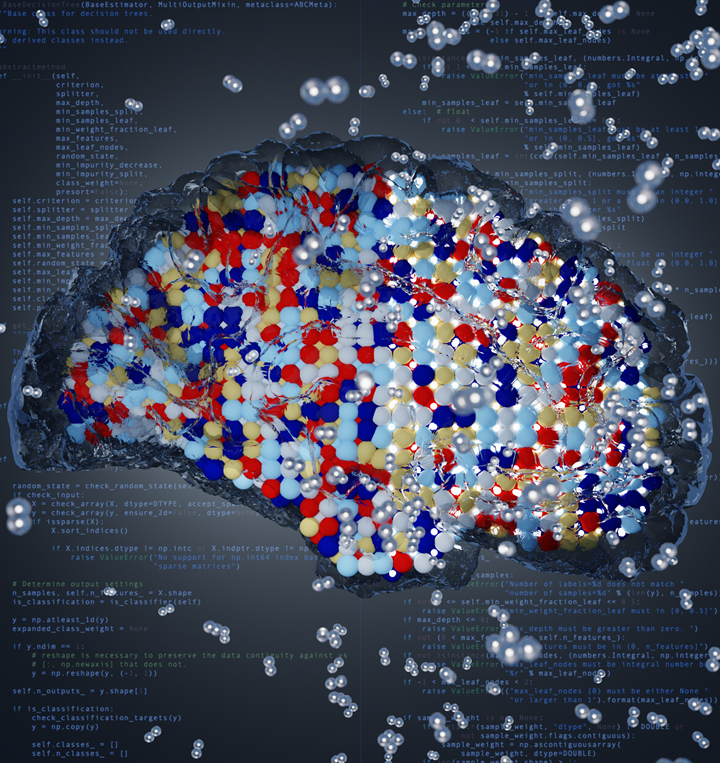
Machine learning can lead to better materials more quickly. (Illustration by Matthew Witman, Sandia)
A team of materials and computer scientists from Sandia National Laboratories, working with international collaborators, have created 12 new alloys that could facilitate the development of a hydrogen infrastructure for consumers.
Fast
They were able to come up with 600 promising materials for hydrogen storage and transmission though a data-driving modeling capability—fast.
Mark Allendorf of Sandia:
“This was accomplished in only 18 months. Without the machine learning it could have taken several years. That’s big when you consider that historically it takes something like 20 years to take a material from lab discovery to commercialization.”
The database of materials is public through the Department of Energy, so it could lead to even more developments.
Remarkable
One of the challenges of hydrogen for vehicle use is that it needs to be compressed from its sea level pressure of about 1 bar to 800 bar for pumping into a car.
According to Vitalie Stavila of Sandia of some of the materials they’ve come up with could replace mechanical compression:
“These high-entropy alloy hydrides could enable a natural cascade compress of hydrogen as it moves through the different materials.”
The hydrogen would be pumped in and, Stavila said, “As hydrogen moves through those layers, it gets more and more pressurized with no mechanical effort.”
Meaning?
There could be small-scale hydrogen generation at the point of fueling, which could then be readily compressed.
///
VW Opens €70-Million Battery Lab
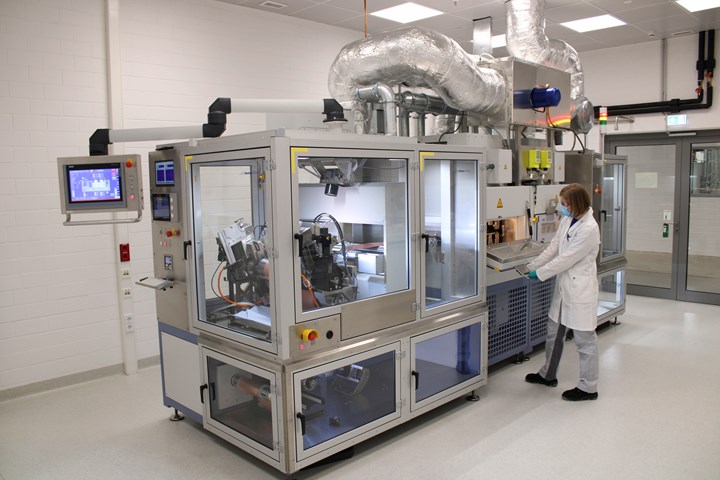
“With our new, state-of-the-art laboratories, we are further expanding our development, process and production expertise for the battery cell – the heart of the battery electric vehicle”, said Thomas Schmall, Group Board Member for Technology at Volkswagen AG and Chairman of the Board of Management of Volkswagen Group Components. (Image: Volkswagen)
Volkswagen Components Group has opened a complex dedicated to developing electric vehicle batteries in Salzgitter, Germany, where Volkswagen Group’s center of excellence for batteries is located.
An objective is to develop a unified cell that can be used across the company’s brands.
VW Group plans to have six cell factories in Europe by 2030 that will produce a combined 240 GWh of batteries. One of those plants will be in Salzgitter, which will go into production—with the unified cell—by 2025.
There are four sections to the new lab:
- Cell development: Materials are developed an evaluated
- Pilot line: Small-scale production of the batteries
- Analytics: Cells are disassembled and competitive analyses are performed
- Environmental & safety: Endurance tests—thermal, electrical and mechanical stresses
VW has great hopes for what is going to come out of Salzgitter: It is looking to reduce battery costs by up to 50%.
Consider
Among the advantages that Tesla has vis-à-vis other OEMs are:
- Battery production at its Gigafactories
- Vehicle charging at its extensive Supercharger network
With its forthcoming battery factories and, in the U.S., the Electrify America charger network, VW seems to be taking a page out of Elon’s proverbial book.
///
NACTOY: From 36 to 23

The jurors of the North American Car, Truck and Utility Vehicle of the Year awards have announced the semifinalists for the 2022 awards, starting with 36 vehicles and winnowing the number down to 23.
In case you are interested in what made the cut (after all, even though the chip shortage is causing the availability of vehicles to be trying, at best, people are still getting new ones when they can):
Cars
- Audi A3
- Cadillac CT5-V Blackwing
- Genesis G70
- Honda Civic
- Lucid Air
- Mercedes-Benz EQS
- Mercedes-Benz S-Class
- Volkswagen Golf Mk VIII (Golf R/Golf GTI)
Trucks
- Ford Maverick
- GMC HUMMER EV
- Hyundai Santa Cruz
- Nissan Frontier
- Rivian R1T
- Toyota Tundra
Utilities
- Ford Bronco
- Genesis GV70
- Hyundai IONIQ 5
- Hyundai Tucson (HEV/ICE/PHEV)
- Jeep Grand Cherokee (ICE, PHEV, L)
- Jeep Wagoneer/Grand Wagoneer
- Kia Carnival
- Nissan Pathfinder
- VW ID.4
Disclosure
I am one of the 50 jurors.
RELATED CONTENT
-
On Ford Maverick, Toyota Tundra Hybrid, and GM's Factory Footprint
GM is transforming its approach to the auto market—and its factories. Ford builds a small truck for the urban market. Toyota builds a full-size pickup and uses a hybrid instead of a diesel. And Faurecia thinks that hydrogen is where the industry is going.
-
Behind the Chevrolet Bolt
There are some cars that are simply profoundly important than others, and when it comes to cars introduced of late, the Chevrolet Bolt is certainly one of those particularly notable cars.
-
On Zeekr, the Price of EVs, and Lighting Design
About Zeekr, failure, the price of EVs, lighting design, and the exceedingly attractive Karma


.jpg;width=70;height=70;mode=crop)






